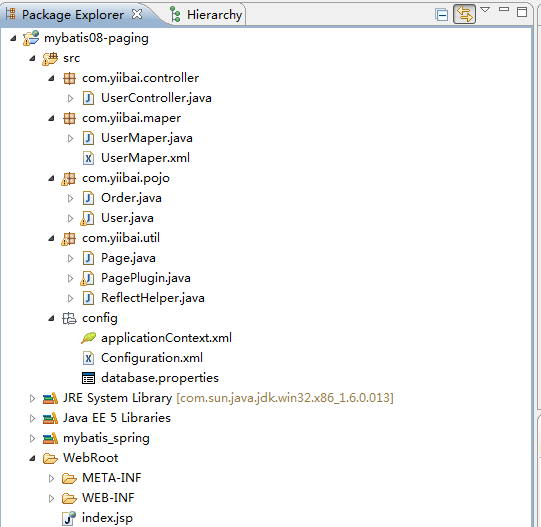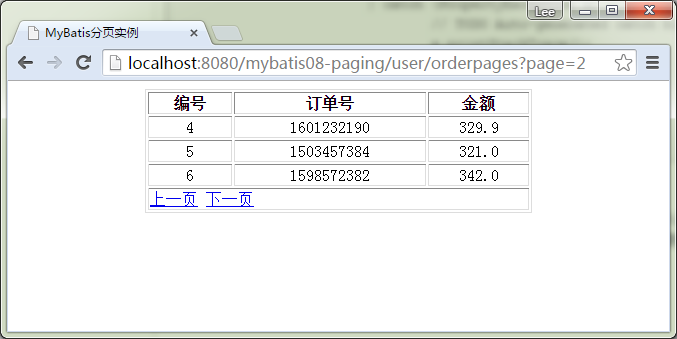MyBatis分页
搞清楚什么是分页(pagination)
例如,在数据库的某个表里有1000条数据,我们每次只显示100条数据,在第1页显示第0到第99条,在第2页显示第100到199条,依次类推,这就是分页。
分页可以分为逻辑分页和物理分页。逻辑分页是我们的程序在显示每页的数据时,首先查询得到表中的1000条数据,然后成熟根据当前页的“页码”选出其中的100条数据来显示。
物理分页是程序先判断出该选出这1000条的第几条到第几条,然后数据库根据程序给出的信息查询出程序需要的100条返回给我们的程序。
MyBatis 物理分页
MyBatis使用RowBounds实现的分页是逻辑分页,也就是先把数据记录全部查询出来,然在再根据 offset 和 limit 截断记录返回。
为了在数据库层面上实现物理分页,又不改变原来 MyBatis 的函数逻辑,可以编写 plugin 截获 MyBatis Executor 的 statementhandler,重写SQL来执行查询。
经常搭框架的人应该都清楚,框架搭建的核心就是配置文件。
在这里我们需要创建 web 工程。也需要用 mybatis与Spring mvc 集成起来,源码在本文结尾处下载,主要有以下几个方面的配置。
整个Mybatis分页示例要完成的步骤如下:
1、示例功能描述
2、创建工程
3、数据库表结构及数据记录
4、实例对象
5、配置文件
6、测试执行,输出结果
1、示例功能描述
在本示例中,需要使用 MyBatis和Spring MVC整合完成分页,完成这样的一个简单功能,即指定一个用户(ID=1),查询出这个用户关联的所有订单分页显示出来(使用的数据库是:MySQL)。
2、创建工程
首先创建一个工程的名称为:mybatis08-paging,在 src 源代码目录下建立文件夹 config,并将原来的 mybatis 配置文件 Configuration.xml 移动到这个文件夹中, 并在 config 文家夹中建立 Spring 配置文件:applicationContext.xml。工程结构目录如下:

3、数据库表结构及数据记录
在本示例中,用到两个表:用户表和订单表,其结构和数据记录如下:
CREATE TABLE `user` (
`id` int(10) unsigned NOT NULL AUTO_INCREMENT,
`username` varchar(64) NOT NULL DEFAULT '',
`mobile` varchar(16) NOT NULL DEFAULT '',
PRIMARY KEY (`id`)
) ENGINE=InnoDB AUTO_INCREMENT=3 DEFAULT CHARSET=utf8; -- ----------------------------
-- Records of user
-- ----------------------------
INSERT INTO `user` VALUES ('1', 'yiibai', '13838009988');
INSERT INTO `user` VALUES ('2', 'saya', '13838009988');
订单表结构和数据如下:
CREATE TABLE `order` (
`order_id` int(10) unsigned NOT NULL AUTO_INCREMENT,
`user_id` int(10) unsigned NOT NULL DEFAULT '0',
`order_no` varchar(16) NOT NULL DEFAULT '',
`money` float(10,2) unsigned DEFAULT '0.00',
PRIMARY KEY (`order_id`)
) ENGINE=InnoDB AUTO_INCREMENT=17 DEFAULT CHARSET=utf8; -- ----------------------------
-- Records of order
-- ----------------------------
INSERT INTO `order` VALUES ('1', '1', '1509289090', '99.90');
INSERT INTO `order` VALUES ('2', '1', '1519289091', '290.80');
INSERT INTO `order` VALUES ('3', '1', '1509294321', '919.90');
INSERT INTO `order` VALUES ('4', '1', '1601232190', '329.90');
INSERT INTO `order` VALUES ('5', '1', '1503457384', '321.00');
INSERT INTO `order` VALUES ('6', '1', '1598572382', '342.00');
INSERT INTO `order` VALUES ('7', '1', '1500845727', '458.00');
INSERT INTO `order` VALUES ('8', '1', '1508458923', '1200.00');
INSERT INTO `order` VALUES ('9', '1', '1504538293', '2109.00');
INSERT INTO `order` VALUES ('10', '1', '1932428723', '5888.00');
INSERT INTO `order` VALUES ('11', '1', '2390423712', '3219.00');
INSERT INTO `order` VALUES ('12', '1', '4587923992', '123.00');
INSERT INTO `order` VALUES ('13', '1', '4095378812', '421.00');
INSERT INTO `order` VALUES ('14', '1', '9423890127', '678.00');
INSERT INTO `order` VALUES ('15', '1', '7859213249', '7689.00');
INSERT INTO `order` VALUES ('16', '1', '4598450230', '909.20');
4、实例对象
用户表和订单表分别对应两个实例对象,分别是:User.java 和 Order.java,它们都在 com.yiibai.pojo 包中。
User.java代码内容如下:
package com.yiibai.pojo; import java.util.List; /**
* @describe: User
* @author: Yiibai
* @version: V1.0
* @copyright http://www.yiibai.com
*/
public class User {
private int id;
private String username;
private String mobile; public int getId() {
return id;
}
public void setId(int id) {
this.id = id;
}
public String getUsername() {
return username;
}
public void setUsername(String username) {
this.username = username;
}
public String getMobile() {
return mobile;
}
public void setMobile(String mobile) {
this.mobile = mobile;
} }
Order.java代码内容如下:
package com.yiibai.pojo; /**
* @describe: User - 订单
* @author: Yiibai
* @version: V1.0
* @copyright http://www.yiibai.com
*/
public class Order {
private int orderId;
private String orderNo;
private float money;
private int userId;
private User user; public int getUserId() {
return userId;
}
public void setUserId(int userId) {
this.userId = userId;
}
public int getOrderId() {
return orderId;
}
public void setOrderId(int orderId) {
this.orderId = orderId;
}
public User getUser() {
return user;
}
public void setUser(User user) {
this.user = user;
}
public String getOrderNo() {
return orderNo;
}
public void setOrderNo(String orderNo) {
this.orderNo = orderNo;
}
public float getMoney() {
return money;
}
public void setMoney(float money) {
this.money = money;
} }
5、配置文件
这个实例中有三个重要的配置文件,它们分别是:applicationContext.xml , Configuration.xml 以及 UserMaper.xml。
applicationContext.xml 配置文件里最主要的配置:
<?xml version="1.0" encoding="utf-8"?>
<beans xmlns="http://www.springframework.org/schema/beans"
xmlns:xsi="http://www.w3.org/2001/XMLSchema-instance" xmlns:aop="http://www.springframework.org/schema/aop"
xmlns:tx="http://www.springframework.org/schema/tx" xmlns:context="http://www.springframework.org/schema/context"
xmlns:p="http://www.springframework.org/schema/p"
xsi:schemaLocation="
http://www.springframework.org/schema/beans http://www.springframework.org/schema/beans/spring-beans-3.0.xsd
http://www.springframework.org/schema/aop http://www.springframework.org/schema/aop/spring-aop-3.0.xsd
http://www.springframework.org/schema/context http://www.springframework.org/schema/context/spring-context-3.0.xsd
http://www.springframework.org/schema/jee http://www.springframework.org/schema/jee/spring-jee-3.0.xsd
http://www.springframework.org/schema/tx http://www.springframework.org/schema/tx/spring-tx-3.0.xsd"
default-autowire="byName" default-lazy-init="false"> <!--本示例采用DBCP连接池,应预先把DBCP的jar包复制到工程的lib目录下。 -->
<context:property-placeholder location="classpath:/config/database.properties" /> <bean id="dataSource" class="org.apache.commons.dbcp.BasicDataSource"
destroy-method="close" p:driverClassName="com.mysql.jdbc.Driver"
p:url="jdbc:mysql://127.0.0.1:3306/yiibai?characterEncoding=utf8"
p:username="root" p:password="" p:maxActive="10" p:maxIdle="10">
</bean> <bean id="transactionManager"
class="org.springframework.jdbc.datasource.DataSourceTransactionManager">
<property name="dataSource" ref="dataSource" />
</bean> <bean id="sqlSessionFactory" class="org.mybatis.spring.SqlSessionFactoryBean">
<!--dataSource属性指定要用到的连接池-->
<property name="dataSource" ref="dataSource" />
<!--configLocation属性指定mybatis的核心配置文件-->
<property name="configLocation" value="classpath:config/Configuration.xml" />
<!-- 所有配置的mapper文件 -->
<property name="mapperLocations" value="classpath*:com/yiibai/mapepr/*.xml" />
</bean> <bean class="org.mybatis.spring.mapper.MapperScannerConfigurer">
<property name="basePackage" value="com.yiibai.maper" />
</bean>
</beans>
配置文件 Configuration.xml 的内容如下:
<?xml version="1.0" encoding="UTF-8" ?>
<!DOCTYPE configuration PUBLIC "-//mybatis.org//DTD Config 3.0//EN"
"http://mybatis.org/dtd/mybatis-3-config.dtd">
<configuration>
<typeAliases>
<typeAlias alias="User" type="com.yiibai.pojo.User"/>
<typeAlias alias="Order" type="com.yiibai.pojo.Order"/>
</typeAliases>
<!-- 与spring 集成之后,这些可以完全删除,数据库连接的管理交给 spring 去管理 -->
<!--
<environments default="development">
<environment id="development">
<transactionManager type="JDBC"/>
<dataSource type="POOLED">
<property name="driver" value="com.mysql.jdbc.Driver"/>
<property name="url" value="jdbc:mysql://127.0.0.1:3306/mybatis?characterEncoding=utf8" />
<property name="username" value="root"/>
<property name="password" value="password"/>
</dataSource>
</environment>
</environments>
--> <!-- 这里交给sqlSessionFactory 的 mapperLocations属性去得到所有配置信息 -->
<!--
<mappers>
<mapper resource="com/yihaomen/mapper/User.xml"/>
</mappers>
--> </configuration>
UserMaper.xml 用于定义查询和数据对象映射,其内容如下:
<?xml version="1.0" encoding="UTF-8" ?>
<!DOCTYPE mapper PUBLIC "-//mybatis.org//DTD Mapper 3.0//EN"
"http://mybatis.org/dtd/mybatis-3-mapper.dtd">
<mapper namespace="com.yiibai.maper.UserMaper"> <!-- 为了返回list 类型而定义的returnMap -->
<resultMap type="User" id="resultUser">
<id column="id" property="id" />
<result column="username" property="username" />
<result column="mobile" property="mobile" />
</resultMap> <!-- User 联合 Order 查询 方法的配置 (多对一的方式) -->
<resultMap id="resultUserOrders" type="Order">
<id property="orderId" column="order_id" />
<result property="orderNo" column="order_no" />
<result property="money" column="money" />
<result property="userId" column="user_id" /> <association property="user" javaType="User">
<id property="id" column="id" />
<result property="username" column="username" />
<result property="mobile" column="mobile" />
</association>
</resultMap> <select id="getUserOrders" parameterType="int" resultMap="resultUserOrders">
SELECT u.*,o.* FROM `user` u, `order` o
WHERE u.id=o.user_id AND u.id=#{id}
</select> <select id="getUserById" resultMap="resultUser" parameterType="int">
SELECT *
FROM user
WHERE id=#{id}
</select>
</mapper>
6、测试执行,输出结果
我们创建一个控制器类在包 com.yiibai.controller 下,类的名称为:UserController.java,这里新增了一个方法:pageList, 对应请求URL是 /orderpages,其代码如下:
package com.yiibai.controller; import java.util.List; import javax.servlet.http.HttpServletRequest;
import javax.servlet.http.HttpServletResponse;
import org.springframework.beans.factory.annotation.Autowired;
import org.springframework.stereotype.Controller;
import org.springframework.web.bind.annotation.RequestMapping;
import org.springframework.web.servlet.ModelAndView; import com.yiibai.maper.UserMaper;
import com.yiibai.pojo.Order;
import com.yiibai.util.Page; // http://localhost:8080/mybatis08-paging/user/orders
@Controller
@RequestMapping("/user")
public class UserController {
@Autowired
UserMaper userMaper; /**
* 某一个用户下的所有订单
*
* @param request
* @param response
* @return
*/
@RequestMapping("/orders")
public ModelAndView listall(HttpServletRequest request,
HttpServletResponse response) {
List<Order> orders = userMaper.getUserOrders(1);
System.out.println("orders");
ModelAndView mav = new ModelAndView("user_orders");
mav.addObject("orders", orders);
return mav;
} /**
* 订单分页
*
* @param request
* @param response
* @return
*/
@RequestMapping("/orderpages")
public ModelAndView pageList(HttpServletRequest request,
HttpServletResponse response) {
int currentPage = request.getParameter("page") == null ? 1 : Integer
.parseInt(request.getParameter("page"));
int pageSize = 3;
if (currentPage <= 0) {
currentPage = 1;
}
int currentResult = (currentPage - 1) * pageSize; System.out.println(request.getRequestURI());
System.out.println(request.getQueryString()); Page page = new Page();
page.setShowCount(pageSize);
page.setCurrentResult(currentResult);
List<Order> orders = userMaper.getOrderListPage(page, 1); System.out.println("Current page =>" + page); int totalCount = page.getTotalResult(); int lastPage = 0;
if (totalCount % pageSize == 0) {
lastPage = totalCount % pageSize;
} else {
lastPage = 1 + totalCount / pageSize;
} if (currentPage >= lastPage) {
currentPage = lastPage;
} String pageStr = ""; pageStr = String.format(
"<a href=\"%s\">上一页</a> <a href=\"%s\">下一页</a>", request
.getRequestURI()
+ "?page=" + (currentPage - 1), request.getRequestURI()
+ "?page=" + (currentPage + 1)); // 制定视图,也就是list.jsp
ModelAndView mav = new ModelAndView("pagelist");
mav.addObject("orders", orders);
mav.addObject("pagelist", pageStr);
return mav;
}
}
注意,在这个分页工程中,在 com.yiibai.util 包下新增了几个类,它们分别是:PagePlugin.java,Page.java, PageHelper.java,其中 PagePlugin 是针对 MyBatis 分页的插件。由于代码太多,这里列出 PagePlugin.java 的代码,其它两个类的代码有兴趣的读者可以在下载代码后阅读取研究。 PagePlugin.java 的代码如下所示:
package com.yiibai.util; import java.lang.reflect.Field;
import java.sql.Connection;
import java.sql.PreparedStatement;
import java.sql.ResultSet;
import java.sql.SQLException;
import java.util.List;
import java.util.Map;
import java.util.Properties; import javax.xml.bind.PropertyException; import org.apache.ibatis.executor.ErrorContext;
import org.apache.ibatis.executor.Executor;
import org.apache.ibatis.executor.ExecutorException;
import org.apache.ibatis.executor.statement.BaseStatementHandler;
import org.apache.ibatis.executor.statement.RoutingStatementHandler;
import org.apache.ibatis.executor.statement.StatementHandler;
import org.apache.ibatis.mapping.BoundSql;
import org.apache.ibatis.mapping.MappedStatement;
import org.apache.ibatis.mapping.ParameterMapping;
import org.apache.ibatis.mapping.ParameterMode;
import org.apache.ibatis.plugin.Interceptor;
import org.apache.ibatis.plugin.Intercepts;
import org.apache.ibatis.plugin.Invocation;
import org.apache.ibatis.plugin.Plugin;
import org.apache.ibatis.plugin.Signature;
import org.apache.ibatis.reflection.MetaObject;
import org.apache.ibatis.reflection.property.PropertyTokenizer;
import org.apache.ibatis.scripting.xmltags.ForEachSqlNode;
import org.apache.ibatis.session.Configuration;
import org.apache.ibatis.session.ResultHandler;
import org.apache.ibatis.session.RowBounds;
import org.apache.ibatis.type.TypeHandler;
import org.apache.ibatis.type.TypeHandlerRegistry; @Intercepts( { @Signature(type = StatementHandler.class, method = "prepare", args = { Connection.class }) })
public class PagePlugin implements Interceptor { private static String dialect = "";
private static String pageSqlId = ""; @SuppressWarnings("unchecked")
public Object intercept(Invocation ivk) throws Throwable { if (ivk.getTarget() instanceof RoutingStatementHandler) {
RoutingStatementHandler statementHandler = (RoutingStatementHandler) ivk
.getTarget();
BaseStatementHandler delegate = (BaseStatementHandler) ReflectHelper
.getValueByFieldName(statementHandler, "delegate");
MappedStatement mappedStatement = (MappedStatement) ReflectHelper
.getValueByFieldName(delegate, "mappedStatement"); if (mappedStatement.getId().matches(pageSqlId)) {
BoundSql boundSql = delegate.getBoundSql();
Object parameterObject = boundSql.getParameterObject();
if (parameterObject == null) {
throw new NullYiibaierException("parameterObject error");
} else {
Connection connection = (Connection) ivk.getArgs()[0];
String sql = boundSql.getSql();
String countSql = "select count(0) from (" + sql
+ ") myCount";
System.out.println("总数sql 语句:" + countSql);
PreparedStatement countStmt = connection
.prepareStatement(countSql);
BoundSql countBS = new BoundSql(mappedStatement
.getConfiguration(), countSql, boundSql
.getParameterMappings(), parameterObject);
setParameters(countStmt, mappedStatement, countBS,
parameterObject);
ResultSet rs = countStmt.executeQuery();
int count = 0;
if (rs.next()) {
count = rs.getInt(1);
}
rs.close();
countStmt.close(); Page page = null;
if (parameterObject instanceof Page) {
page = (Page) parameterObject;
page.setTotalResult(count);
} else if (parameterObject instanceof Map) {
Map<String, Object> map = (Map<String, Object>) parameterObject;
page = (Page) map.get("page");
if (page == null)
page = new Page();
page.setTotalResult(count);
} else {
Field pageField = ReflectHelper.getFieldByFieldName(
parameterObject, "page");
if (pageField != null) {
page = (Page) ReflectHelper.getValueByFieldName(
parameterObject, "page");
if (page == null)
page = new Page();
page.setTotalResult(count);
ReflectHelper.setValueByFieldName(parameterObject,
"page", page);
} else {
throw new NoSuchFieldException(parameterObject
.getClass().getName());
}
}
String pageSql = generatePageSql(sql, page);
System.out.println("page sql:" + pageSql);
ReflectHelper.setValueByFieldName(boundSql, "sql", pageSql);
}
}
}
return ivk.proceed();
} private void setParameters(PreparedStatement ps,
MappedStatement mappedStatement, BoundSql boundSql,
Object parameterObject) throws SQLException {
ErrorContext.instance().activity("setting parameters").object(
mappedStatement.getParameterMap().getId());
List<ParameterMapping> parameterMappings = boundSql
.getParameterMappings();
if (parameterMappings != null) {
Configuration configuration = mappedStatement.getConfiguration();
TypeHandlerRegistry typeHandlerRegistry = configuration
.getTypeHandlerRegistry();
MetaObject metaObject = parameterObject == null ? null
: configuration.newMetaObject(parameterObject);
for (int i = 0; i < parameterMappings.size(); i++) {
ParameterMapping parameterMapping = parameterMappings.get(i);
if (parameterMapping.getMode() != ParameterMode.OUT) {
Object value;
String propertyName = parameterMapping.getProperty();
PropertyTokenizer prop = new PropertyTokenizer(propertyName);
if (parameterObject == null) {
value = null;
} else if (typeHandlerRegistry
.hasTypeHandler(parameterObject.getClass())) {
value = parameterObject;
} else if (boundSql.hasAdditionalParameter(propertyName)) {
value = boundSql.getAdditionalParameter(propertyName);
} else if (propertyName
.startsWith(ForEachSqlNode.ITEM_PREFIX)
&& boundSql.hasAdditionalParameter(prop.getName())) {
value = boundSql.getAdditionalParameter(prop.getName());
if (value != null) {
value = configuration.newMetaObject(value)
.getValue(
propertyName.substring(prop
.getName().length()));
}
} else {
value = metaObject == null ? null : metaObject
.getValue(propertyName);
}
TypeHandler typeHandler = parameterMapping.getTypeHandler();
if (typeHandler == null) {
throw new ExecutorException(
"There was no TypeHandler found for parameter "
+ propertyName + " of statement "
+ mappedStatement.getId());
}
typeHandler.setParameter(ps, i + 1, value, parameterMapping
.getJdbcType());
}
}
}
} private String generatePageSql(String sql, Page page) {
if (page != null && (dialect != null || !dialect.equals(""))) {
StringBuffer pageSql = new StringBuffer();
if ("mysql".equals(dialect)) {
pageSql.append(sql);
pageSql.append(" limit " + page.getCurrentResult() + ","
+ page.getShowCount());
} else if ("oracle".equals(dialect)) {
pageSql
.append("select * from (select tmp_tb.*,ROWNUM row_id from (");
pageSql.append(sql);
pageSql.append(") tmp_tb where ROWNUM<=");
pageSql.append(page.getCurrentResult() + page.getShowCount());
pageSql.append(") where row_id>");
pageSql.append(page.getCurrentResult());
}
return pageSql.toString();
} else {
return sql;
}
} public Object plugin(Object arg0) {
// TODO Auto-generated method stub
return Plugin.wrap(arg0, this);
} public void setProperties(Properties p) {
dialect = p.getProperty("dialect");
if (dialect == null || dialect.equals("")) {
try {
throw new PropertyException("dialect property is not found!");
} catch (PropertyException e) {
// TODO Auto-generated catch block
e.printStackTrace();
}
}
pageSqlId = p.getProperty("pageSqlId");
if (dialect == null || dialect.equals("")) {
try {
throw new PropertyException("pageSqlId property is not found!");
} catch (PropertyException e) {
// TODO Auto-generated catch block
e.printStackTrace();
}
}
} }
接下来部署 mybatis08-paging 这个工程,启动 tomcat ,打开浏览器输入网址:http://localhost:8080/mybatis08-paging/user/orderpages ,显示结果如下:

MyBatis分页的更多相关文章
- Mybatis分页插件
mybatis配置 <!-- mybatis分页插件 --> <bean id="pagehelper" class="com.github.pageh ...
- Mybatis分页和Spring的集成
写了一个Mybatis分页控件,在这记录一下使用方式. 在Maven中加入依赖: ? 1 2 3 4 5 6 7 8 9 <dependencies> ... <depe ...
- mybatis分页插件以及懒加载
1. 延迟加载 延迟加载的意义在于,虽然是关联查询,但不是及时将关联的数据查询出来,而且在需要的时候进行查询. 开启延迟加载: <setting name="lazyLoading ...
- Mybatis分页插件PageHelper的配置和使用方法
Mybatis分页插件PageHelper的配置和使用方法 前言 在web开发过程中涉及到表格时,例如dataTable,就会产生分页的需求,通常我们将分页方式分为两种:前端分页和后端分页. 前端分 ...
- Mybatis分页插件PageHelper使用
一. Mybatis分页插件PageHelper使用 1.不使用插件如何分页: 使用mybatis实现: 1)接口: List<Student> selectStudent(Map< ...
- mybatis分页练手
最近碰到个需求,要做个透明的mybatis分页功能,描述如下:目标:搜索列表的Controller action要和原先保持一样,并且返回的json需要有分页信息,如: @ResponseBody @ ...
- SSM 使用 mybatis 分页插件 pagehepler 实现分页
使用分页插件的原因,简化了sql代码的写法,实现较好的物理分页,比写一段完整的分页sql代码,也能减少了误差性. Mybatis分页插件 demo 项目地址:https://gitee.com/fre ...
- Mybatis分页插件——PageHelper
1.引入依赖 <!-- mybatis分页插件 --> <dependency> <groupId>com.github.pagehelper</groupI ...
- Spring data Jpa 分页从1开始,查询方法兼容 Mybatis,分页参数兼容Jqgrid
废话少说 有参数可以设置 在org.springframework.boot.autoconfigure.data.web.SpringDataWebProperties 中 /** * Whethe ...
- MyBatis 分页之拦截器实现
分页是WEB程序中常见的功能,mybatis分页实现与hibernate不同,相比hibernate,mybatis实现分页更为麻烦.mybatis实现分页需要自己编写(非逻辑分页RowBounds) ...
随机推荐
- kernel dump Analysis
https://social.msdn.microsoft.com/Forums/vstudio/en-US/0c418482-7edd-4c91-b7f4-6005d550244a/got-the- ...
- Gitlab日常备份和恢复
按照官方安装文档安装完成之后的/home/git目录结构如下,这里我大致翻译官方的内容,部分加上自己的话,英语功力捉急,请见谅 |-- home | |-- git | |-- .ssh | |-- ...
- 多媒体文件格式之AVI
[时间:2016-07] [状态:Open] AVI(Audio Video Interleaved的缩写)是一种RIFF(Resource Interchange File Format的缩写)文件 ...
- mac下增加eclipse内存
在mac上找不到eclipse.ini文件编辑内存限制,在eclipse安装目录右击eclipse程序,选“显示包内容”,eclipse.ini就在 Content/MacOS下.
- iOS高版本备份恢复到低版本系统的方法
一般来说,在更新iOS系统的时候我们都会建议大家先用iTunes对系统进行完整备份.但时不时都会有人偷懒,或者使用手机OTA升级而没有对系统备份,最终导致不满意新系统了,想降级却无备份可以恢复的尴尬局 ...
- 【机器学习】随机森林(Random Forest)
随机森林是一个最近比较火的算法 它有很多的优点: 在数据集上表现良好 在当前的很多数据集上,相对其他算法有着很大的优势 它能够处理很高维度(feature很多)的数据,并且不用做特征选择 在训练完后, ...
- django signal
@receiver(post_save, sender=User) def create_account(sender, instance=None, **kwargs): if instance i ...
- java中判断字节数组的编码方式是不是UTF-8
1,用google的工具包,配置maven: <!-- https://mvnrepository.com/artifact/com.googlecode.juniversalchardet/j ...
- [转]Oracle中Hint深入理解
原文地址:http://czmmiao.iteye.com/blog/1478465 Hint概述 基于代价的优化器是很聪明的,在绝大多数情况下它会选择正确的优化器,减轻了DBA的负担.但有时它也聪明 ...
- pthread_cond_wait和pthread_cond_signal以及互斥变量的使用情况
#include <stdio.h> #include <stdlib.h> #include <unistd.h> #include <pthread.h& ...
